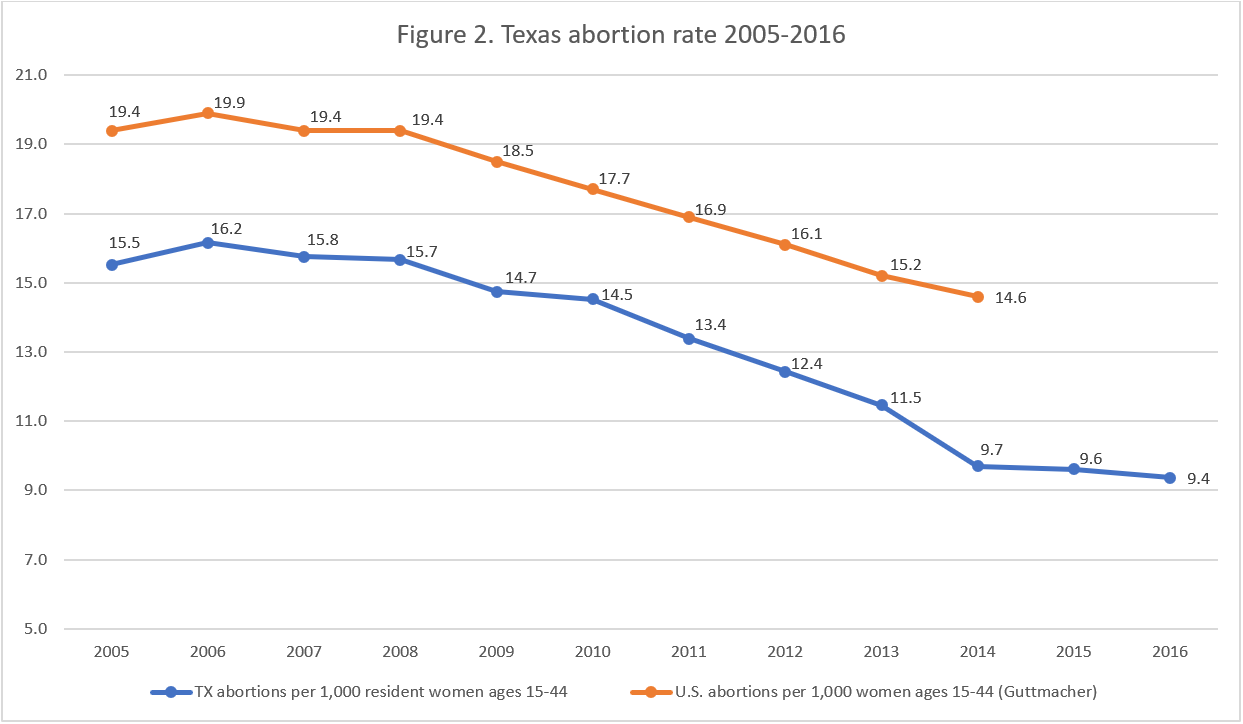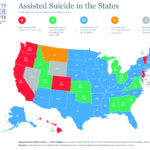Abortion Reporting: Texas (2016)

Texas’ abortion report for 2016 was published in May 2019. Texas abortion reporting is now handled by the Texas Department of Health and Human Services.
Changes in Texas Abortions, 2015-2016

*Information on Texas’ state abortion rate and Planned Parenthood’s Texas market share is not publicly available.
Abortion Totals and Trends
There were 54,507 Texas abortions in 2016, down 1.4 percent from 2015 and down 30 percent from 2001 (Fig. 1). Twenty-three percent of these were chemical abortions. Chemical abortions rose by 114 percent from 2015, although the 12,568 chemical abortions reported in 2015 is still below the total number of chemical abortions reported in 2013, when Texas enacted new safety standards for abortion facilities and doctors. Texas does not report the state abortion rate, but CLI estimates that the rate was 9.4 abortions per 1,000 women of childbearing age, down from 9.6 in 2015 (Fig. 2).
State Report Summary
Of the 54,507 abortions reported by Texas for 2016, 98 percent were performed on Texas residents. This includes 1,026 abortions that were performed on Texas residents who traveled to other states for their abortions. Two percent were performed on women from other states.
Nine percent of the abortions were on women under the age of 20. More than half, 58 percent, were performed on women in their twenties. Twenty-nine percent were performed on women in their thirties, and three percent on women ages 40 and up. Thirty-eight percent were on Hispanic women, 28 percent on white women, and 26 percent on black women. Six percent of the abortions were performed on Asian women, compared to just 0.3 percent on Native American women and one percent on women of other races. Another 0.4 percent were performed on women whose race was not reported.
Texas measures the length of pregnancies using post-fertilization age, which is approximately two weeks later than gestational age. In 2016, 81 percent of Texas abortions were performed earlier than nine weeks post-fertilization (11 weeks of gestation). Eight percent were performed between nine and 10 weeks, five percent between 11 and 12 weeks, and three percent between 13 and 14 weeks post-fertilization. Two percent of the abortions occurred between 15 and 16 weeks, and an additional two percent occurred between 17 and 20 weeks. There were 55 abortions that were performed between 21 and 24 weeks post-fertilization and 22 abortions performed at 25 weeks post-fertilization or later. Of the 77 abortions performed after 20 weeks post-fertilization, 62 were performed on Texas residents in other states. Since October 2013, Texas law has prohibited abortions after 20 weeks post-fertilization unless the mother’s life or a major bodily function is at risk or the baby has an abnormality. The Texas legislature considered whether to remove the abnormality exception from the law but did not pass the bill before the legislative session ended.
Just over half of Texas abortions (52 percent) were performed in abortion centers that were licensed as ambulatory surgery centers, and 46 percent were performed in abortion centers that were licensed as abortion facilities. There were 155 abortions (less than half a percent) that were performed in hospitals and 47 abortions that were performed in physicians’ offices. Not quite two percent of the abortions were performed out-of-state. Suction curettage was the most common abortion procedure, used to perform 70 percent of Texas abortions. Twenty-three percent of the abortions were chemical, and six percent were performed using dilation and evacuation. Sixty-four abortions were performed using sharp curettage, 12 abortions via intrauterine instillation, and one abortion by means of a hysterectomy or hysterotomy. One percent of the abortions were performed using other, unspecified procedures.
Some of the information in Texas’ abortion report is for resident abortions only – including the 1,026 abortions that were performed on Texas residents in other states – rather than all the women who obtained abortions in Texas. Eighty-three percent of the Texas residents who underwent abortions in 2016 were unmarried. Seventeen percent were married.
Thirty-eight percent of the resident abortions were performed on women with no previous live births. A quarter were on women with one prior live birth, and 37 percent were performed on women with more than one live birth. Sixty-one percent of the abortions were performed on women who had never had an abortion previously. Twenty-six percent were on women with one prior abortion, and 13 percent on women with two or more previous abortions.
There were no live births or maternal deaths resulting from abortion that were reported in 2016. There were 21 reported abortion complications: one uterine perforation, two cervical lacerations, seven hemorrhages, two cases of infection or sepsis, and nine other, unspecified complications. However, it is likely that some complications went unreported. As CLI associate scholar Dr. Donna Harrison points out, self-reporting of complications by abortion providers misses many of the complications that occur once a woman has left the abortion center. The Texas legislature has recognized this problem, passing an abortion complication reporting law in 2017 to require health care facilities to report abortion-related complications they encounter to the Texas Health and Human Services Commission.
Texas Safety Regulations
In 2013, Texas passed a law requiring doctors who perform abortions to have admitting privileges at a hospital within 30 miles of their abortion facilities. Texas also required abortion centers to abide by ambulatory surgery center standards. Both laws were challenged in court, and in 2016, the U.S. Supreme Court overturned the laws as unconstitutional. There were 42 abortion centers in Texas when the law was passed. Many closed after being unable to meet the new safety standards, and 21 abortion centers are now in operation in Texas. Texas’ annual abortion totals dropped in 2014 and have remained lower than those reported in 2013 and previous years. However, the number of chemical abortions has begun to trend upward.
Recently, CLI published a peer-reviewed study on abortion providers in Florida and their use of the hospital. The study found that only about half of the abortion providers have hospital privileges, and most of those physicians use the hospital infrequently.
State Ranking
In CLI’s 2016 study that evaluated abortion reporting across the 50 states, New York City, and the District of Columbia, Texas’ reports were ranked at 15th place. Texas has made improvements to its abortion reporting since then by passing a law requiring that all abortion complications be reported. Texas could further improve its reporting by including information on Texas’ informed consent and parental consent processes and women’s reasons for choosing abortion. Additionally, the Lone Star State could release its reports more quickly – Texas released its 2016 data three years later in May 2019, making it the 45th state to release abortion data from 2016. Abortion continues to be a divisive issue in Texas politics, making current abortion statistics a valuable resource to Texas citizens, researchers, and lawmakers.


- Texas does not report the state abortion rate. Rates were calculated by the Charlotte Lozier Institute using population estimates from the United States Census Bureau. The rates were calculated using the following formula: (abortions occurring in Texas and on Texas residents out of state ÷ number of resident women ages 15-44) x 1,000.
Click here to view reporting from:2024202320222021202020192017






























